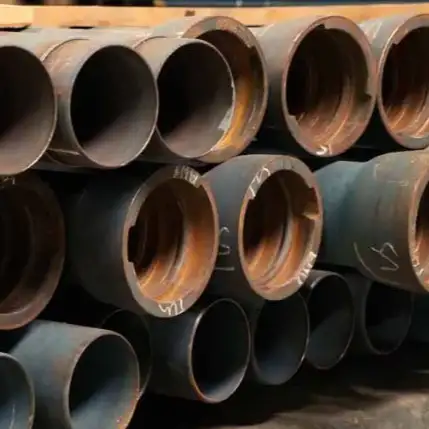I’ve worked on countless gas‑piping projects, and one question I always encounter is: “Can I use black iron pipe for natural gas and propane?” The short answer: yes—but only when done correctly. In this article, I’ll walk you through the technical standards, installation best practices, pros and cons, comparisons, and real‑world applications.
1. Overview of Black Iron Pipe in Gas Applications
I remember when I first saw a black iron (steel) pipe being used in a basement gas line — it looked rugged and reliable. Black iron pipe (also called “black steel”) has been a workhorse for fuel‑gas delivery for over a century. It’s still widely used in both natural gas and propane systems for several key reasons:
-
Strength & durability: Built tough, suitable for high‑pressure applications.
-
Threaded joints: Create leak‑tight connections when installed properly.
-
Service flexibility: Works well with above‑ground and underground routing.
But it’s not without drawbacks—chiefly susceptibility to corrosion, especially outdoors or underground. That makes corrosion control essential, and we’ll talk about that in section 5.
2. Regulatory Standards & Code Requirements
Here’s the heart of compliance:
-
Steel (black) or galvanized pipe is permitted for gas applications when sized Schedule 40 or heavier, and must comply with recognized standards (e.g., ASTM).
-
Underground installations must be at least Schedule 80 or heavier if pressure exceeds 100 psi.
-
Threaded or welded joints are required—not slip or compression fittings.
-
Material approvals: All valves, fittings, and gaskets must be rated for gas use and stamped accordingly.
-
Corrosion protection: Above‑ground steel must be painted or galvanized; buried steel needs coatings like WRAS or epoxy, not just galvanized .
These codes are enforced via building and plumbing inspection and governed by ICC Fuel‑Gas Code (IFGC), National Fuel Gas Code (NFPA 54), and local regulations.
3. Technical Pros and Cons
✅ Advantages
-
High pressure tolerance
-
Proven reliability
-
Widely available and cost‑efficient
⚠️ Disadvantages
-
Corrosion risk: needs protective coatings or wrapping.
-
Labor‑intensive installation: threading requires two wrenches and torque control.
-
Weight: it’s heavier and bulkier than alternatives like CSST or PE.
🛠️ Alternatives include:
-
CSST (corrugated stainless steel tubing): flexible, easier to route but needs bonding and lightning protection.
-
HDPE (polyethylene): excellent for underground use, corrosion‑free, but less common for propane.
-
Copper: professional only, subject to limited approval and lifespan (~20 years).
4. Comparison Table
| Feature | Black Iron Pipe | Galvanized Steel | CSST | HDPE |
|---|---|---|---|---|
| Regulatory approval | Yes (IFGC/NFPA) | Yes, in some areas | Yes (with bonding req’d) | Yes (underground only) |
| Corrosion protection | Paint / epoxy / coating | Built‑in galvanizing | Stainless, internal‑only | Non‑corrosive |
| Jointing method | Thread/weld | Thread/weld | Compression/factory crimps | Heat fusion or fittings |
| Flexibility of routing | Limited—rigid lengths | Rigid | Highly flexible | Coiled in rolls, flexible |
| Labor intensity | High | High | Moderate | Moderate |
| Typical use | Indoor & buried gas | Often outdoor/exposed | Indoor gas distribution | Underground gas main runs |
5. Installation & Corrosion Control Best Practices
Drawing from years in the field, here’s my refined checklist:
-
Prep: Deburr ends; clean threads.
-
Thread sealant: Use PTFE gas-rated tape or compound—avoid plumbers’ tape.
-
Anti‑corrosion:
-
Above‑ground: prime, then paint with rust-converting enamel.
-
Below‑ground: wrap with factory-applied PE/epoxy.
-
-
Support & expansion allowance: Install per code; allow movement from expansion.
-
Proper painting/marking: Label pipes “GAS” in yellow per ANSI A13.1.
-
Pressure testing: Minimum 1.5× working pressure or at least 3 psi; use inert gas and leak detection.
-
Local inspections: Engage code officials and check local AHJ; galvanized may be required outdoors by some jurisdictions .
6. Case Study: Residential Propane System
Scenario
A homeowner in rural Canada wants a fixed propane furnace and grill hookup using black iron.
Installation Steps
-
Main line: Great‑Black‑Pipe, Schedule 40, from tank to meter outside.
-
Underground portion: Coated with PE and at least 18″ deep.
-
Above‑ground: Painted with rust-proof enamel, labeled in yellow “PROPANE” and “GAS.”
-
Joints: Threaded with PTFE and torque controlled.
-
Inspection & pressure test: 1.5× pressure, inert gas, soap-leak test.
-
Outcome: System passed inspection, in service for 3 years with no leaks or corrosion—owner reports safe, reliable operation.
7. Frequently Asked Questions
1. Can I mix black iron with galvanized pipe?
Yes—both comply when properly threaded or welded. A galvanized exterior helps resist corrosion, and mixing is code‑permissible.
2. What pipe schedule is required underground?
Use Schedule 80 or heavier when working pressures exceed 100 psi.
3. Is black iron acceptable for outdoor use?
Yes—if painted or primed. Many AHJs may require galvanized or painted black iron in outdoor installations.
4. How do I prevent corrosion underground?
Use factory-coated (PE or epoxy) pipe and backfill with sand. Don’t rely solely on galvanizing for buried pipe .
5. Can black iron be used for both natural gas and propane?
Absolutely—as long as it meets the correct schedule, seals properly, and is protected against corrosion .
8. Conclusion
Black iron pipe remains a trusted, cost‑effective choice for natural gas and propane piping—if installed per code:
-
Use Schedule 40 or heavier (Schedule 80 for underground high‑pressure).
-
Thread or weld joints; use approved sealants.
-
Protect against corrosion (painting, wrapping, galvanizing).
-
Pressure‑test and follow local codes.
When done properly, it offers decades of safe, reliable service. Make sure to consult codebooks such as IFGC, NFPA 54, ANSI/ASME, and your AHJ. If doubts arise, work with a licensed gas technician. I’ve seen both success stories and failures—proper installation always makes the difference.

